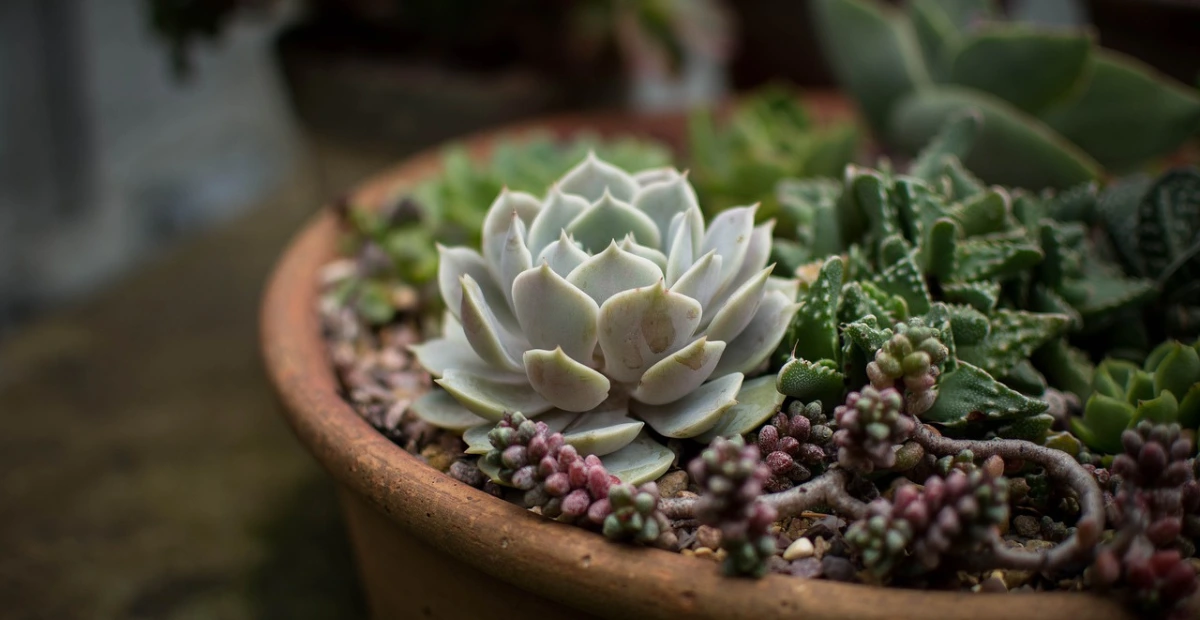Introduction: The Joy of Growing Echeveria Succulents
Have you ever admired the delicate, rosette-shaped beauty of an Echeveria succulent? Their striking colors and low-maintenance nature make them a favorite among plant enthusiasts. Whether you’re a seasoned gardener or new to the world of succulents, taking care of your Echeveria can feel like a rewarding challenge—especially when you learn how to keep it thriving year-round.
advertisement
This guide is designed to provide you with everything you need to ensure your Echeveria succulent remains healthy and vibrant, no matter the season. From understanding its basic needs to learning the nuances of seasonal care, you’ll find the insights you need to make your plant the centerpiece of your space.
Understanding Your Echeveria Succulent’s Needs
What is an Echeveria Succulent?
Echeveria succulents are a genus of flowering plants that belong to the Crassulaceae family, known for their rosette-shaped clusters of thick, fleshy leaves. Native to Mexico and parts of Central and South America, these plants have adapted to survive in dry, arid climates by storing water in their leaves. They are available in a variety of colors, including shades of green, purple, red, and blue.
What makes Echeveria succulents so special is their beauty and hardiness. These plants are often chosen by those looking for a low-maintenance houseplant that still adds a pop of color and charm to their home or garden. Whether grown indoors or outdoors, Echeveria is a versatile plant that can be a perfect addition to any space.
Why Echeveria is a Great Choice for Your Home
There’s no doubt that Echeveria succulents are fantastic for both beginner and experienced plant lovers. Here’s why:
- Low Maintenance: Echeveria succulents are relatively easy to care for compared to other plants. They don’t require frequent watering, and they thrive in well-lit areas.
- Space Friendly: These plants don’t require a lot of room to grow, making them ideal for small apartments or offices.
- Aesthetic Appeal: With their unique rosette shape and a variety of vibrant colors, Echeveria succulents are visually striking and can elevate the décor of any room.
advertisement
Seasonal Care Tips for Your Echeveria Succulent
One of the key elements to keeping your Echeveria succulent healthy throughout the year is understanding how to adjust your care routine with the changing seasons. Here are the essentials:
Echeveria Succulent Care in Spring & Summer
Sunlight Needs
During the warmer months, your Echeveria succulent will thrive best with plenty of sunlight. Aim for at least 6+ hours of direct sunlight every day to ensure the plant is photosynthesizing effectively. These plants are used to bright, sun-drenched environments, so don’t be afraid to place them near a window with plenty of light.
Watering
Spring and summer are the growing seasons for Echeveria, so they need regular watering, but don’t overdo it. It’s important to wait until the soil is completely dry before watering again. Overwatering is one of the most common mistakes, so make sure the pot has drainage holes to allow excess water to escape. Water thoroughly but sparingly—these plants are drought-tolerant and don’t need frequent hydration.
Temperature
Echeveria succulents thrive in temperatures between 65-85°F (18-29°C). If your plant is indoors, ensure it’s placed in a warm location away from drafts or extreme heat. Outdoors, they enjoy warm, dry conditions, but if temperatures rise above 90°F (32°C), you may need to move your plant to a slightly shaded area to prevent sunburn.
Fertilizing
During the spring and summer months, your Echeveria will be actively growing. This is the time to feed it with a balanced, water-soluble fertilizer. Fertilizing once a month during these seasons will encourage healthy growth and vibrant color.
advertisement
Echeveria Succulent Care in Fall & Winter
Adjusting Watering Routine
As the weather cools down, your Echeveria will enter a dormant phase. During fall and winter, reduce watering to avoid waterlogging the roots. Water only when the soil has completely dried out. Overwatering in these months is a sure way to damage your plant.
Sunlight Adjustments
With fewer daylight hours during the fall and winter, your Echeveria may not be getting enough sunlight. If it’s indoors, move it to a brighter location or consider using a grow light to supplement natural light. If your plant is outdoors, try to place it in a sunny spot, but be mindful of the cooler temperatures.
Temperature Considerations
Keep your Echeveria succulent away from drafts and ensure the temperature stays above 50°F (10°C). Cold temperatures can damage the plant, especially if it’s exposed to frost. In areas with freezing winters, bring your Echeveria indoors or protect it from harsh weather.
Common Echeveria Succulent Problems and How to Solve Them
While Echeveria succulents are resilient, they can encounter a few problems. The good news is that most of these issues can be prevented or solved with the right care.
Overwatering: The Silent Killer
Overwatering is the leading cause of death for Echeveria succulents. If you notice yellowing leaves, soft and mushy stems, or root rot, it’s likely that you’ve been watering too frequently.
advertisement
Solution: Ensure that your pot has drainage holes and use well-draining soil. Always wait until the soil is dry to the touch before watering again. If you’ve already overwatered, reduce watering immediately and let the plant dry out completely.
Underwatering: A Dry Dilemma
If you notice shriveled or dry leaves, your plant may be underwatered. Echeveria succulents need water during the warmer months, but they can go through longer periods of drought in cooler weather.
Solution: Water your plant thoroughly, ensuring that water reaches the roots. A consistent watering schedule helps prevent these issues, but be mindful not to overwater.
Pests and Diseases
Though rare, pests like mealybugs, aphids, and scale insects may infest your Echeveria. Additionally, fungal diseases like powdery mildew can occur when the plant is exposed to excessive moisture or humidity.
Solution: If pests appear, treat the plant with insecticidal soap or neem oil. If mildew appears, remove infected leaves and improve air circulation around the plant.
How to Propagate Your Echeveria Succulent
One of the best ways to expand your Echeveria collection or share plants with others is through propagation. Here’s how you can easily propagate your Echeveria by leaf cuttings or offsets.
Propagation by Leaf Cuttings
- Select a healthy leaf from the plant.
- Gently twist or cut the leaf from the stem.
- Let the leaf dry for 1-2 days to allow the wound to callus over.
- Plant the callused leaf in a container filled with well-draining soil.
- Water sparingly, and wait for roots to develop.
Propagation by Offsets (Pups)
Echeveria succulents produce small offshoots, also called pups, that can be separated and planted in their own pots. To propagate:
advertisement
- Gently remove the pup from the parent plant.
- Let it dry out for 1-2 days.
- Plant the pup in its own pot and follow the same care routine as the parent plant.
Essential Tools for Echeveria Succulent Care
To ensure that your Echeveria succulent thrives, make sure you have the right tools:
- Pot with drainage holes: This ensures proper drainage and prevents root rot.
- Well-draining soil: A cactus or succulent mix will work best for your Echeveria.
- Pruning shears: Use these for trimming dead or damaged leaves.
- Watering can with a long spout: A watering can with a narrow spout allows you to water your plant without soaking the leaves.
Creating the Perfect Environment for Your Echeveria Succulent
Where you place your Echeveria is crucial for its health. These plants thrive in bright light and warm temperatures, so consider these environmental tips:
Indoors
- Place your Echeveria near a south or west-facing window for optimal sunlight. If natural light is limited, consider a grow light to supplement.
- Keep the temperature stable—between 65-85°F—and avoid placing the plant near drafts, heating vents, or air conditioners.
Outdoors
- Outdoors, Echeveria succulents love sunny patios, balconies, or gardens. Choose a spot that gets at least 6 hours of direct sunlight.
- In cooler climates, bring your plant inside when temperatures dip below 50°F.
Humidity
advertisement
- Echeveria succulents prefer dry air, so avoid placing them in bathrooms or kitchens where humidity levels are high.
Conclusion: Enjoying Your Thriving Echeveria Succulent
Taking care of your Echeveria succulent can be a fun and rewarding experience. By following the seasonal care tips, understanding common problems, and making small adjustments to your care routine, you can ensure that your Echeveria thrives all year round. Whether you’re propagating new plants or simply enjoying the beauty of a healthy one, your Echeveria succulent will continue to bring color and life to your home for years to come.
Ready to keep your Echeveria thriving? Start with the basics today and watch your plant flourish!
FAQ Section
Q: How often should I water my Echeveria succulent?
A: Water your Echeveria once the soil is completely dry, usually every 7-10 days in the growing season. Reduce watering in fall and winter.
Q: Why are my Echeveria succulent’s leaves turning yellow?
A: Yellowing leaves are often a sign of overwatering. Check the soil’s moisture level and adjust your watering routine accordingly.
Q: Can I grow Echeveria succulents outdoors?
A: Yes, Echeveria succulents can be grown outdoors in sunny, warm locations, but be sure to protect them from frost and extreme cold.
Q: What is the best soil for Echeveria succulents?
A: Use well-draining soil, like a cactus or succulent mix, to ensure proper moisture levels and prevent root rot.
advertisement
By following these steps, you’ll be on your way to cultivating a thriving, beautiful Echeveria succulent that will bring lasting joy to your home or garden. Happy planting!


